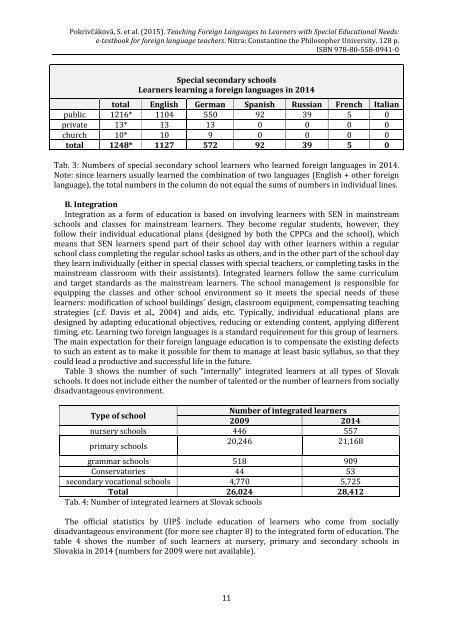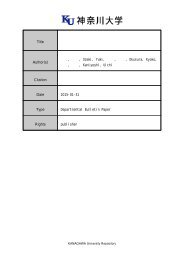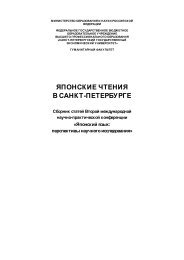to Learners with Special Educational Needs
e-textbook SEN
e-textbook SEN
Create successful ePaper yourself
Turn your PDF publications into a flip-book with our unique Google optimized e-Paper software.
Pokrivčáková, S. et al. (2015). Teaching Foreign Languages <strong>to</strong> <strong>Learners</strong> <strong>with</strong> <strong>Special</strong> <strong>Educational</strong> <strong>Needs</strong>:<br />
e-textbook for foreign language teachers. Nitra: Constantine the Philosopher University. 128 p.<br />
ISBN 978-80-558-0941-0<br />
<strong>Special</strong> secondary schools<br />
<strong>Learners</strong> learning a foreign languages in 2014<br />
<strong>to</strong>tal English German Spanish Russian French Italian<br />
public 1216* 1104 550 92 39 5 0<br />
private 13* 13 13 0 0 0 0<br />
church 10* 10 9 0 0 0 0<br />
<strong>to</strong>tal 1248* 1127 572 92 39 5 0<br />
Tab. 3: Numbers of special secondary school learners who learned foreign languages in 2014.<br />
Note: since learners usually learned the combination of two languages (English + other foreign<br />
language), the <strong>to</strong>tal numbers in the column do not equal the sums of numbers in individual lines.<br />
B. Integration<br />
Integration as a form of education is based on involving learners <strong>with</strong> SEN in mainstream<br />
schools and classes for mainstream learners. They become regular students, however, they<br />
follow their individual educational plans (designed by both the CPPCs and the school), which<br />
means that SEN learners spend part of their school day <strong>with</strong> other learners <strong>with</strong>in a regular<br />
school class completing the regular school tasks as others, and in the other part of the school day<br />
they learn individually (either in special classes <strong>with</strong> special teachers, or completing tasks in the<br />
mainstream classroom <strong>with</strong> their assistants). Integrated learners follow the same curriculum<br />
and target standards as the mainstream learners. The school management is responsible for<br />
equipping the classes and other school environment so it meets the special needs of these<br />
learners: modification of school buildings´ design, classroom equipment, compensating teaching<br />
strategies (c.f. Davis et al., 2004) and aids, etc. Typically, individual educational plans are<br />
designed by adapting educational objectives, reducing or extending content, applying different<br />
timing, etc. Learning two foreign languages is a standard requirement for this group of learners.<br />
The main expectation for their foreign language education is <strong>to</strong> compensate the existing defects<br />
<strong>to</strong> such an extent as <strong>to</strong> make it possible for them <strong>to</strong> manage at least basic syllabus, so that they<br />
could lead a productive and successful life in the future.<br />
Table 3 shows the number of such “internally” integrated learners at all types of Slovak<br />
schools. It does not include either the number of talented or the number of learners from socially<br />
disadvantageous environment.<br />
Type of school<br />
Number of integrated learners<br />
2009 2014<br />
nursery schools 446 557<br />
primary schools<br />
20,246 21,168<br />
grammar schools 518 909<br />
Conserva<strong>to</strong>ries 44 53<br />
secondary vocational schools 4,770 5,725<br />
Total 26,024 28,412<br />
Tab. 4: Number of integrated learners at Slovak schools<br />
The official statistics by UIPŠ include education of learners who come from socially<br />
disadvantageous environment (for more see chapter 8) <strong>to</strong> the integrated form of education. The<br />
table 4 shows the number of such learners at nursery, primary and secondary schools in<br />
Slovakia in 2014 (numbers for 2009 were not available).<br />
11






